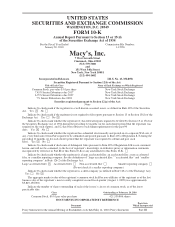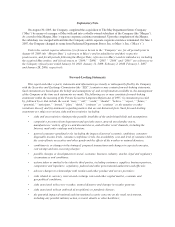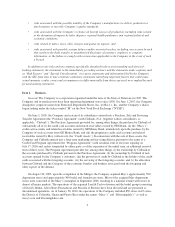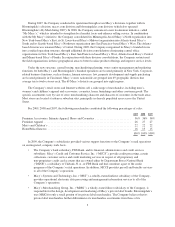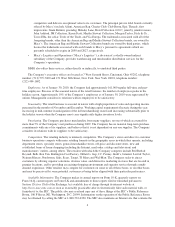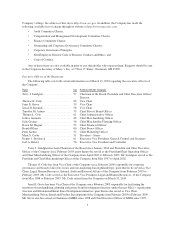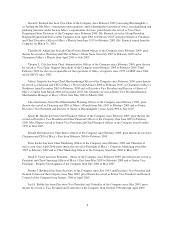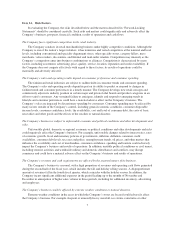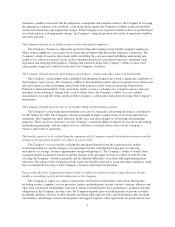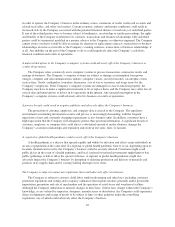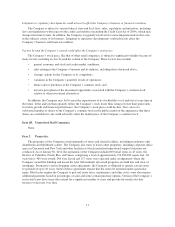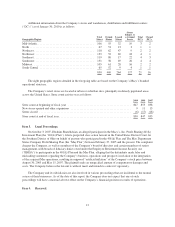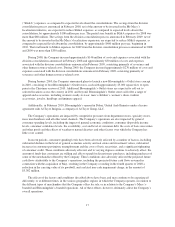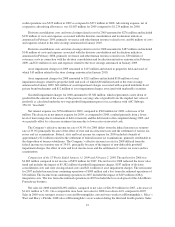Macy's 2009 Annual Report Download - page 15
Download and view the complete annual report
Please find page 15 of the 2009 Macy's annual report below. You can navigate through the pages in the report by either clicking on the pages listed below, or by using the keyword search tool below to find specific information within the annual report.numerous variables associated with the judgments, assumptions and estimates made by the Company in assessing
the appropriate valuation of its goodwill, could in the future require the Company to further reduce its goodwill
and record related non-cash impairment charges. If the Company were required to further reduce its goodwill and
record related non-cash impairment charges, the Company’s financial position and results of operations would be
adversely affected.
The Company depends on its ability to attract and retain quality employees.
The Company’s business is dependent upon attracting and retaining a large number of quality employees.
Many of these employees are in entry level or part-time positions with historically high rates of turnover. The
Company’s ability to meet its labor needs while controlling the costs associated with hiring and training new
employees is subject to external factors such as unemployment levels, prevailing wage rates, minimum wage
legislation and changing demographics. Changes that adversely impact the Company’s ability to attract and
retain quality employees could adversely affect the Company’s business.
The Company depends upon its relationships with designers, vendors and other sources of merchandise.
The Company’s relationships with established and emerging designers have been a significant contributor to
the Company’s past success. The Company’s ability to find qualified vendors and access products in a timely and
efficient manner is often challenging, particularly with respect to goods sourced outside the United States.
Political or financial instability, trade restrictions, tariffs, currency exchange rates, transport capacity and costs
and other factors relating to foreign trade, each of which affects the Company’s ability to access suitable
merchandise on acceptable terms, are beyond the Company’s control and could adversely impact the Company’s
performance.
The Company depends upon the success of its advertising and marketing programs.
The Company’s advertising and promotional costs, net of cooperative advertising allowances, amounted to
$1,087 million for 2009. The Company’s business depends on high customer traffic in its stores and effective
marketing. The Company has many initiatives in this area, and often changes its advertising and marketing
programs. There can be no assurance as to the Company’s continued ability to effectively execute its advertising
and marketing programs, and any failure to do so could have a material adverse effect on the Company’s
business and results of operations.
The benefits expected to be realized from the expansion of the Company’s market localization initiatives and the
changes to its operating structure are subject to various risks.
The Company’s success in fully realizing the anticipated benefits from the expansion of its market
localization initiatives and the changes to its operating structure will depend in large part on achieving
anticipated cost savings, business opportunities and growth prospects. The Company’s ability to benefit from
expanded market localization initiatives and the changes to its operating structure is subject to both the risks
affecting the Company’s business generally and the inherent difficulties associated with implementing these
initiatives. The failure of the Company to fully realize the benefits expected to result from these initiatives could
have a material adverse effect on the Company’s business and results of operations.
Parties with whom the Company does business may be subject to insolvency risks or may otherwise become
unable or unwilling to perform their obligations to the Company.
The Company is a party to contracts, transactions and business relationships with various third parties,
including vendors, suppliers, service providers, lenders and participants in joint ventures, strategic alliances and
other joint commercial relationships, pursuant to which such third parties have performance, payment and other
obligations to the Company. In some cases, the Company depends upon such third parties to provide essential
leaseholds, products, services or other benefits, including with respect to store and distribution center locations,
merchandise, advertising, software development and support, logistics, other agreements for goods and services
9


